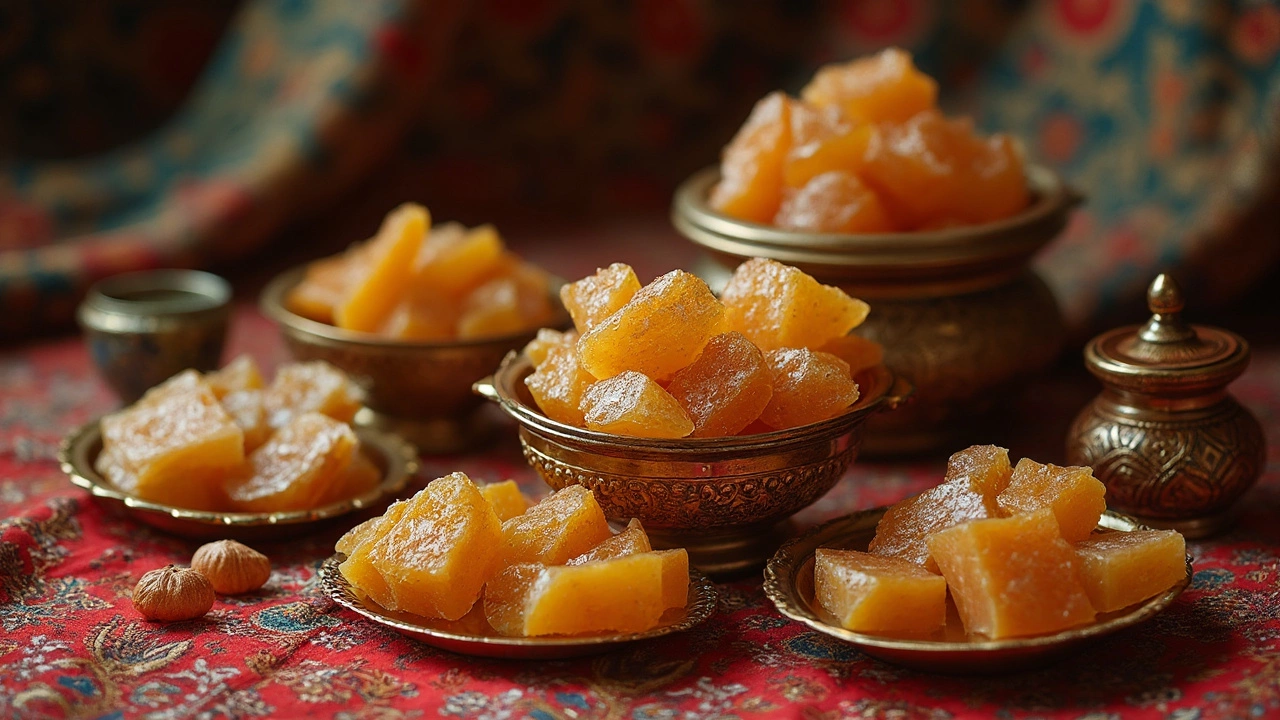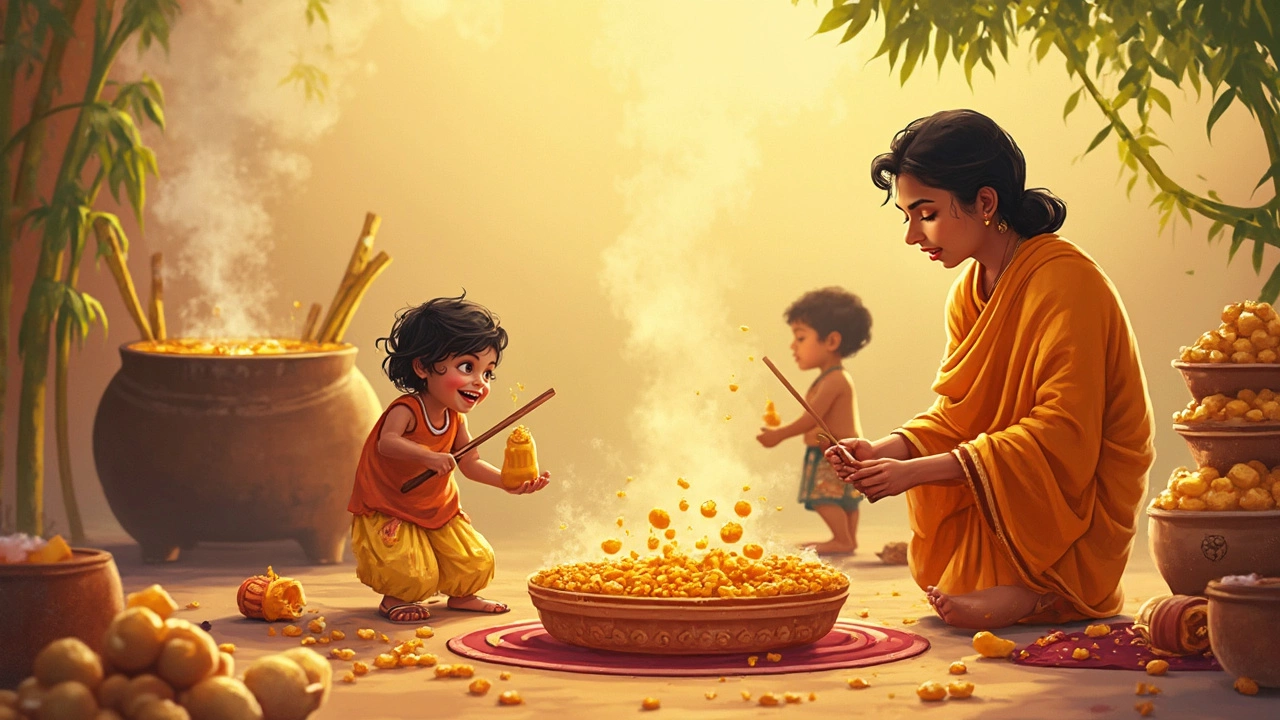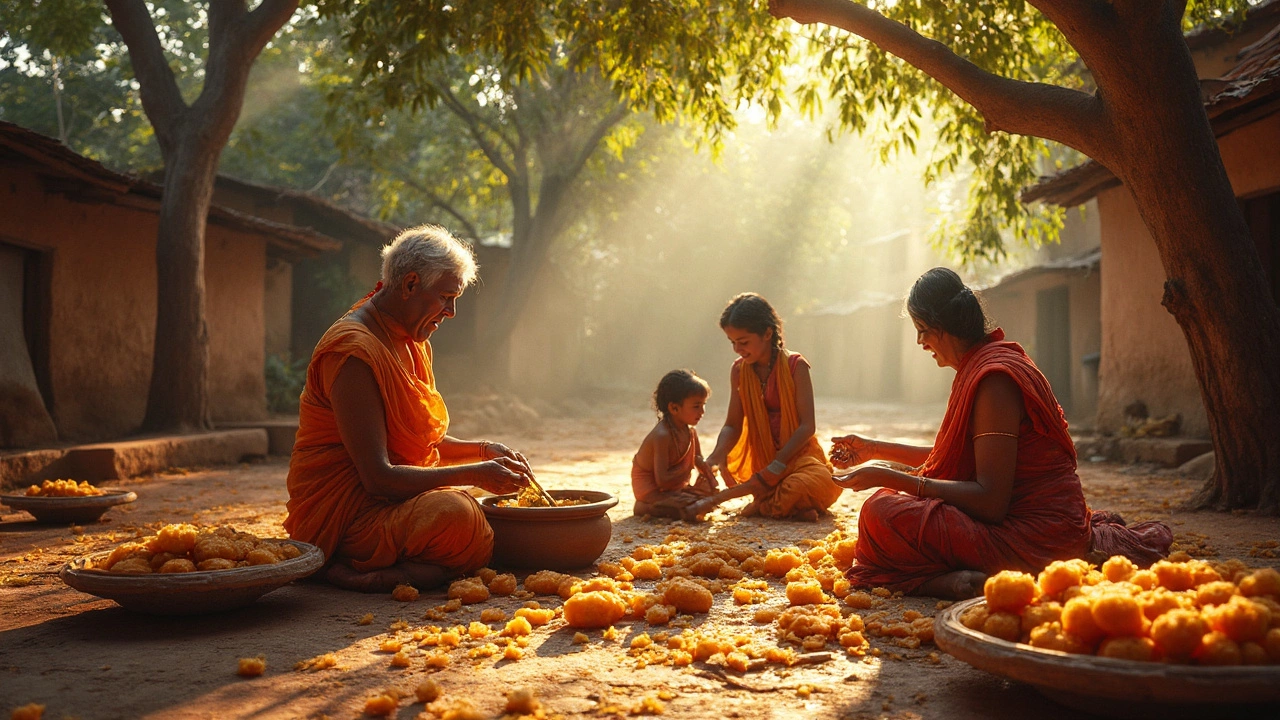11 May 2025
- 0 Comments
Guess what? Candy didn’t start with colorful wrappers or sugar pouring out of factories. In India, it goes way back—think before anyone had even heard about commercial sugar. The classics aren’t just simple treats, they’re little history lessons with every bite.
Let’s talk about jaggery. It’s the grandparent of all Indian sweets—just boiled sugarcane or palm sap, cooling into golden chunks called “guda.” People in ancient India would munch on this sticky, caramel-like stuff, and some families still make it by hand today. These old-school candies needed almost nothing fancy, just a good stir and the right amount of patience.
Want to know why these sweets stuck around? They’re full of flavor, easy to whip up, and honestly, pretty good for you compared to modern processed sugar bombs. Stick around if you want to try a recipe or two that’s older than most family trees.
- Earliest Sweets: India Before Sugar
- Meet the Ancestor: Guda and the Birth of Jaggery Candy
- From Guda to Misri: Sugar Steps Into the Picture
- Sweets that Stayed: Why Classics Never Fade
- Make It Yourself: Ancient Candy, Modern Kitchen
Earliest Sweets: India Before Sugar
When people talk about Indian sweets, most imagine plates of laddus and barfis. But those came later. The real OG sweets in India started way before sugar was even a thing. Back then, candies were all about natural stuff you could find around you—mainly jaggery, honey, dried fruits, and sometimes even sweet roots or flowers.
Way back in the Vedic times (think 1500 BCE!), folks didn’t know about refined sugar. Instead, they relied on jaggery (guda or gur) and raw honey to make everything sweet. Both of these gave energy, tasted great, and didn’t need complex processing. Honey straight from the hive was used to sweeten drinks or just eaten with fruits.
One popular treat was simple chunks of jaggery, which people chewed as candy or melted into porridges. Another common option was dried dates or figs—nature’s own candy. They’d wrap these in leaves or cook them into simple desserts, especially for feasts and temple rituals.
If you like nerding out over numbers, check this out:
| Sweetener | Main Source | Usage Period in Ancient India | Common Use |
|---|---|---|---|
| Jaggery (Guda) | Sugarcane, Date Palm Sap | Since 1500 BCE | Candy, Porridge, Ritual Offerings |
| Honey | Bee Hives | Since 2000 BCE | Drinks, Eaten Raw, Temple Prasad |
| Dried Fruits | Date, Fig, Raisin | Prehistoric | Standalone Snack, Mixed into Dishes |
No fancy tools needed—just clean hands, clay pots, and a fire. It was all about keeping things simple and making do with what you had. So if you’re thinking the oldest Indian candy came out of a shop, it was more likely made in someone’s backyard, sweetened by the sun and time.
Meet the Ancestor: Guda and the Birth of Jaggery Candy
If you want to talk about the oldest Indian candy, you have to start with guda. Guda isn't some fancy sweet shop legend—it’s just jaggery pressed into chunks, and it’s been around for thousands of years. Early records, even as old as the Vedas, mention people eating jaggery and using it for festivals, pujas, and just everyday snacking. In old texts, 'guda' literally means lump sugar, and back then, jaggery was candy.
What makes guda special? You only need two things: sugarcane or palm sap and some heat. When sugarcane juice boils and gets thick, it turns golden and sticky. Pour it out and let it cool—there you go, instant traditional candy. Even today, in rural parts, you’ll see families making it with big iron pans and lots of muscle power, just like their grandparents did.
Guda is different from the refined sugar kids are used to today. It’s got a deep flavor—sort of caramel and earthy at the same time. Plus, it keeps trace minerals from the sugarcane, which is why older generations keep saying it’s "better for you." You’ll still find guda being handed out during harvest festivals or as prasad in temples. Some households even make little balls of jaggery mixed with peanuts, coconut, or til (sesame seeds) for quick snacks.
- Homemade Jaggery Candy: Boil sugarcane juice for an hour until it thickens and bubbles. Keep stirring!
- When it’s the right color and consistency, pour it onto a flat, greased plate.
- Let it cool, then cut into chunks. You don’t need anything complicated—just patience and strong arms.
Honestly, candy in India started out pretty healthy and doable. Guda proves you don’t need modern tools to craft something delicious—and it’s still an easy project if you want to taste ancient India at home.

From Guda to Misri: Sugar Steps Into the Picture
India didn’t just give the world a sweet tooth—it actually gave the world sugar. For centuries, people used jaggery (guda) as their go-to candy and sweetener. But things changed around the 5th century CE when Indian craftsmen nailed down a way to crystallize sugar. That’s how misri, or rock sugar, was born. This wasn’t a coincidence—it happened thanks to simple, clever experiments with sugarcane juice right in village kitchens.
So why is misri such a big deal? First off, misri is probably the oldest form of real sugar candy in India and maybe on the entire planet. Sanskrit texts from more than 1,500 years ago talk about its use. The word "khanda" shows up in ancient documents—and get this, it’s where the English word “candy” comes from. That’s how deep the Indian candy story goes.
Making misri at home was (and still is) pretty basic: boil sugarcane juice, cool it down, and let it slowly turn into giant, shiny crystals. Families in many villages just tie a string in the syrup and wait for crystals to stick. No fancy gear, just patience and a knack for timing.
Misri quickly found its way into kitchens, medicine cabinets, and prayers. People used it to cool off in hot weather, soothe a sore throat, or make offerings at temples. Misri mixed with fennel seed is still the go-to after-meal treat in restaurants and weddings. It’s sweet, a little crunchy, and feels old-school in all the best ways.
Want a fun fact? Persian and Greek traders who visited India took this technique back home, spreading sugar-making knowledge across the world. Next time you pop a piece of misri, it’s basically a bite of world history.
Sweets that Stayed: Why Classics Never Fade
It’s wild how some Indian candies have basically time-traveled from ancient kitchens to our current snack boxes. But there are real reasons why treats like gud chikki (jaggery brittle), sesame laddoos, and misri keep popping up on plates, festival after festival, even as new sweets flood the market.
The biggest reason? These sweets are simple but hit all the right notes—crunchy, chewy, sweet, and even a little earthy. Families can easily make them at home with just two or three ingredients. There’s no waiting in line at fancy stores or mastering impossible techniques. Plus, you know exactly what’s in them.
Look, these sweets aren’t just tasty—they’re packed with tradition and even some health perks. Jaggery, for example, isn’t just any sweetener; it still holds a special spot because it’s less processed than plain sugar and brings in iron, minerals, and a natural boost of energy.
Festivals like Makar Sankranti and Lohri would feel weird without jaggery or sesame candies. That’s not just nostalgia talking, that’s real—these treats have tags in religious rituals, winter health tips passed down by grandmas, and even in Ayurvedic practices. A pinch of sesame here, a bit of jaggery there, and you’ve got dessert and medicine rolled into one.
| Classic Sweet | Main Ingredients | Popular At |
|---|---|---|
| Gur Chikki | Jaggery, peanuts | Makar Sankranti |
| Til Laddoo | Sesame seeds, jaggery | Lohri, Pongal |
| Misri | Sugar crystals | Religious offerings |
So, what keeps the oldest Indian candy and its cousins on top? Speed, taste, health vibes, and, let’s be honest, a little bit of family pressure! Even with easy fixes like store-bought chocolate, these time-tested sweets always show up at the right moment—sometimes as prasad at the temple, sometimes as a quick post-meal extra, or even slipped into your school tiffin as a surprise treat. They’re way more than just sugar—they’re part of the rhythm of daily Indian life.

Make It Yourself: Ancient Candy, Modern Kitchen
Ever wanted to try your hand at the oldest Indian candy? The cool thing is, these age-old treats use super basic kitchen stuff—no fancy gear or weird ingredients. People have been making them for centuries using pots, a stove, and a little muscle power.
The main star? Jaggery. You’ll find it shaped like blocks or little discs in any Indian grocery store. It’s unrefined sugar made by boiling sugarcane juice until it thickens up, then poured into molds. If you’ve got some jaggery and a stove, you’re halfway to real ancient Indian candy.
- Jaggery Chunks (Guda): Old-fashioned candies were literally just broken-up bits of cooled jaggery. Let it cool, smash it up, and munch away. Some folks add roasted peanuts or sesame seeds for flavor and crunch.
- Jaggery Peanut Brittle (Chikki): Melt about 1 cup jaggery with 2 spoons of water on medium heat until it bubbles and thickens (seriously, watch it closely). Mix in roasted peanuts, quickly spread the mix on an oiled plate, flatten it with a spatula or rolling pin, then cut while it’s warm. That’s it.
The best part? These homemade sweets skip all the preservatives, and you can control exactly what goes in. Try using sesame seeds, puffed rice, or even coconut if you’re not a peanut fan.
A little tip: Get your ingredients ready before you start melting jaggery. It sets fast—don’t try answering calls in between! If you want a softer candy, take it off the heat earlier; for something snappy and brittle, keep it bubbling a little longer.
These sweets don’t need anything extra to taste amazing. They store well in airtight jars for a couple weeks, so you can keep a stash handy. Homemade truly means you’re tasting the history of India—one old-school bite at a time.
